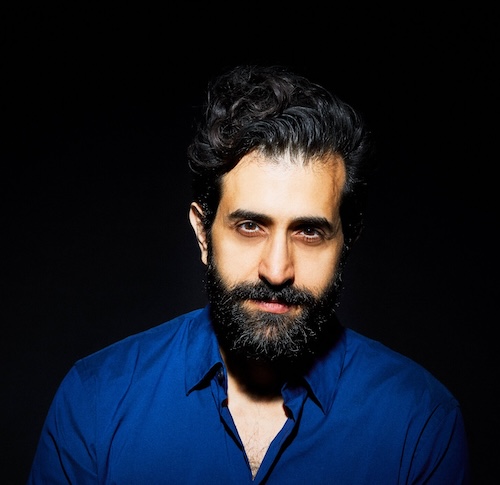New World members make impressive showing in wide-ranging program

Tenor Karim Sulayman performed Britten’s Nocturne with members of the New World Symphony on Sunday. Photo: Jon Wes
Despite a rainy afternoon and the nearby boat show crowds and traffic, a sizable audience turned out for the New World Symphony’s chamber music concert Sunday in Miami Beach. The orchestral academy’s fellows offered a hefty and diverse program with a star turn by Lebanese-American tenor Karim Sulayman at the New World Center.
Sulayman did the solo honors in A Dove Peered In by Michael Linville after Hildegard von Bingen. This instrumental setting of the Medieval abbess’ song by Linville—New World’a director of instrumental performance—is wildly imaginative, featuring trombones, oboe d’amore and a huge variety of gongs among the ensemble. The opening oboe d’amore solo was evocative and von Bingen’s song lilting and mesmerizing. Sulayman’s light tenor conveyed the perfumed scent of von Bingen’s text with its allusions to the natural world.
Sulayman tackled a larger work with Benjamin Britten’s Nocturne for tenor and chamber orchestra. The 1958 work, a setting of poems by nine British writers centering on the subject of night, is not top-drawer Britten. Conceived as a successor to the Serenade for tenor, horn and strings—one of the composer’s best scores—the Nocturne too often sounds like outtakes or rejected sketches for a Britten opera.
Still, it has some effective moments. The moody English horn introduction to Wilfred Owen’s “The Kind Ghosts” effectively sets up the poet’s evocation of the darkness of death. There is a charming, airy sensibility to “Sleep and Poetry” (to a text by John Keats), almost like a modernist salon ditty. Britten paints the shadow and light of Shakespeare’s “Sonnet No. 43” in eerie colors.
Sulayman’s strong English diction made the text projections almost unnecessary. His artful phrasing and dexterity in the high register totally fulfilled the demands of Britten’s darting vocal lines. At times, Sulayman’s projection was fiercely stentorian, at others soft and soothing. He is a skilled, charismatic artist who one wants to hear more from.
Linville conducted Britten’s dark rumination with clarity and momentum and the players brought spot-on accuracy to the complex instrumental writing. One of the interesting aspects of the score is that eight of the nine movements feature prominent solo instrumental parts. Maggie O’Leary (bassoon), Sooyoung Kim (English horn), Henry Bond (French horn), Abigail Kent (harp) and Micah Harrow (timpani) deserve special kudos for their prominent solo work.
The concert opened with Debussy’s Sonata for flute, viola and harp. In this late,14-minute creation, Debussy distilled the essence of his impressionistic vision, bereft of flashy flourishes. In the second movement Interlude, there are touches of the Orientalism that was sweeping French artistic circles in the early decades of the twentieth century.
Flutist Minha Kim’s full tonal range, perfect intonation and agile leaps between registers were the stellar fulcrum of an excellent reading. Kent brought clarity and exactness to the harp’s arpeggiated strands. Mario Rivera offered a welcome vigorous and gutsy iteration of the important viola role. The three players blended to alluring aural effect.
Beethoven’s Quintet in C Major for strings, Op. 29 is an early piece that finds the composer working under the spell of classicism. Yet his own voice still finds its way, and there is much graceful scoring and inspired thematic invention for the five instruments.
It took the performance one movement to fully fall into place. At first, violinist Dominique Bégin seemed lacking in strength and his sound was wavery, and not always blending with his colleagues. With the Adagio molto espressivo, Bégin’s solo soared in burnished tones and the ensemble began to come together. This movement finds Beethoven at his lyrical best and violists Seth Van Embden and Shek Wan Li and cellist Hana Cohon brought depth of sonority to the engaging melodies.
With Bégin and violinist Singyi Rebecca Hou really digging in at full force, the Scherzo was emblazoned with Haydnesque wit and ballast. Bégin was fully on top of the cadenza-like passages that open the finale and there were smiles from the players when they assayed the brusque chords that interrupted the secondary episode, which was played with grace and beauty.
Throughout the concert, standing ovations followed the performances. The entire presentation was a model of intelligent programming that challenged players and listeners alike.
The New World Symphony’s next chamber music program presents Wynton Marsalis’ A Fiddler’s Tale, 2 p.m. March 24 at the New World Center in Miami Beach. nws.edu
Posted in Performances
Leave a Comment
Mon Feb 19, 2024
at 12:53 pm
No Comments